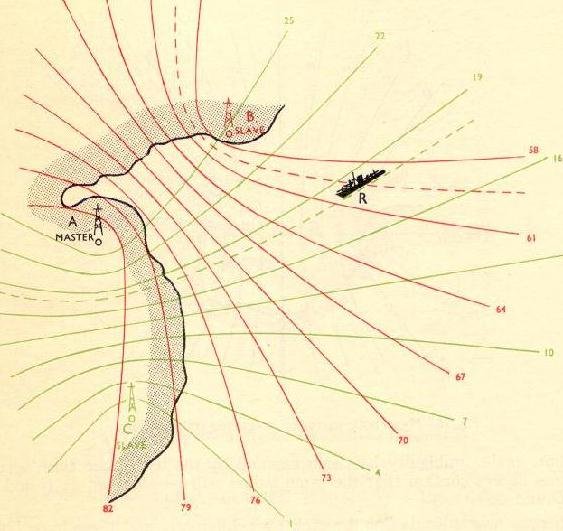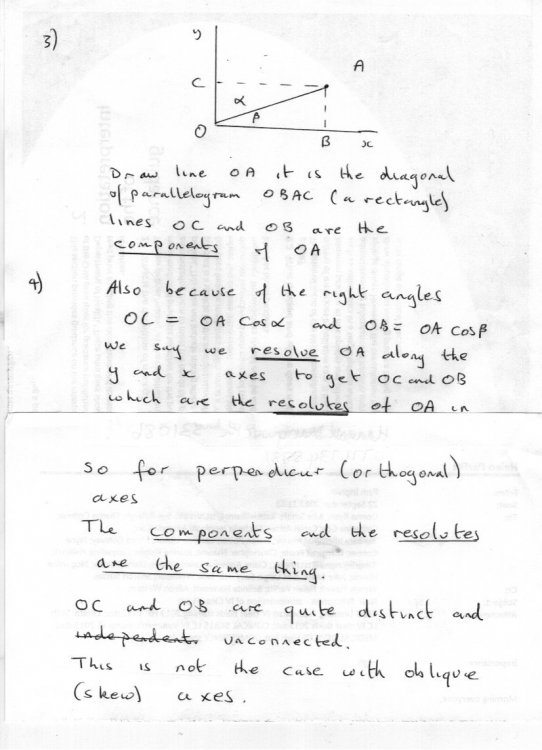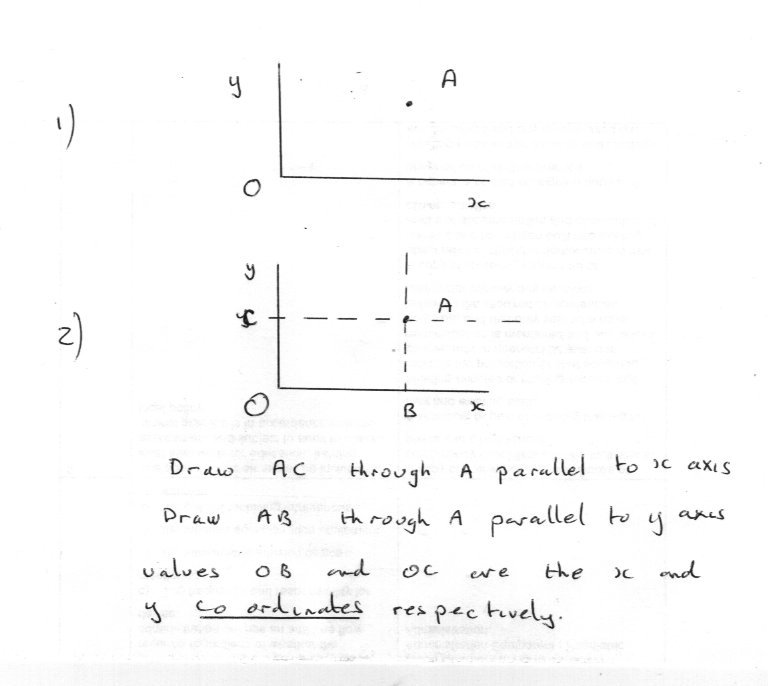-
Posts
18315 -
Joined
-
Last visited
-
Days Won
104
Content Type
Profiles
Forums
Events
Everything posted by studiot
-
I do hope you are not creating unneccessary work for others and confusing 'laid back' with 'lazy'.
-

Curved coordinates and the frame of reference that applies to them
studiot replied to geordief's topic in Relativity
I believe it was Marcus Hanke, (though it may have been Mordred) who recently advised against messing with curved or skew coordinate systems for the reasons I was going to publish, largely along the lines of geordie's post. Yes they are more difficult, that is why they are avoided when practicable. However they have had much use, I was going to say that Radio Navigation systems have been in use since the 1920s, but Wiki says that the earliest recorded one was 1907. Here is a hyperbolic system due to Decca. -
In what way is this Modern and Theoretical Physics, not a speculation on your part ? What Modern and Theoretical Physics is used ?
-

Curved coordinates and the frame of reference that applies to them
studiot replied to geordief's topic in Relativity
Since this topic is about coordinates, it is a good idea to understand what they are and mean. I think the place to start is with familiar simple rectangular coordinates. Bear with me and check these over first because we are all so used to these that important differences come as a surprise when we move to oblique and curvilinear coordinates. And many curvilinear systems are oblique. The surprises come that oblique axes contain a little bit of each axis in components and resolutes and curved axes add the additional complication of the curve and deciding what parallel means. This mixing has implications for transformation between coordinate systems and derivatives in differential geometry. -
I don't know how Turkish is constructed, but the letters in English are divided into vowels and consonants. T is a consonant and many consonants come in pairs. The halves of the pair are called the voiced and unvoiced consonants of the pair. That is because the sound is formed partly by exhaling a puff of air through the voicebox and partly by the shape and configuration of the mouth and tongue. With a voiced and unvoiced consonants the mouth/tongue configuration is the same, but the voiced version is also sounded in the chest and voicebox. The voiced version is louder and more pronounced than the unvoiced version. So the t (teh) sound is the unvoiced version and the d (deh) sound the voiced counterpart. Other pairs include s and z; p and b. The voiced version is louder more pronounced than the unvoiced version.
-
Thanks. +1 @Zahra B Good luck with your exam. If you are studying this you need to be familiar with the M-M equation so now is the time to ask anything else. I'm sure CharonY can answer any bio questions about it better than I can.
-

Curved coordinates and the frame of reference that applies to them
studiot replied to geordief's topic in Relativity
I think you will find that the idea of a frame came along well before relativity in the early days of classical differential geometry. I don't know if it was introduced by Frenet or someone else but consider two space curves, one a dead straight line and the other a coil spring or helix. In classical geometry we have the fixed frame in which these curves reside and we can obtain equations of the line or helix in terms of the fixed frame. However we can also consider these curves as 'generated' by a moving set of axes that also twists and turns as it moves from one point to the next. The differential geometry amounts to calculatiing the change in orientation of this 'moving frame'. I don't have the time at the moment to draw helpful pictures but google 'frenet frames' and choose images should produce plenty. -
Sorry you haven't got the idea. But then this is algebra and I expect you are a bioscientist. Remember that the M-M equation is not concentration v time whose slope is the rate. It is a graph of rate v concentration so starts of at the origin when the rate must be zero if the concentration is zero. Let is consider the M-M equation [math]v = \frac{{{V_{\max }}\left[ S \right]}}{{{K_m} + \left[ S \right]}}[/math] [math]When\quad {K_m} = \left[ S \right]\quad then[/math] [math]v = \frac{{{V_{\max }}\left[ S \right]}}{{\left[ S \right] + \left[ S \right]}} = \frac{{{V_{\max }}\left[ S \right]}}{{2\left[ S \right]}} = \frac{{{V_{\max }}}}{2}[/math] Now this gives us two points on the x, y graph of the M-M equation, in the linear region. the point (0, 0) where concentration (x axis) = zero and the rate (y axis) = 0 and the point where the concentration (x axis) =Vmax/2 and the concentration (y axis) = KM Because we are in the linear region we can redefine the equation in that region as rate = slope x concentration We do not need to 'shift it' So at our two known points [math]slope = \frac{{\left( {{y_2} - {y_1}} \right)}}{{\left( {{x_2} - {x_1}} \right)}} = \frac{{\left( {\frac{{{V_{\max }}}}{2} - 0} \right)}}{{\left( {{K_m} - 0} \right)}} = \frac{{{V_{\max }}}}{{2{K_m}}}[/math] Which give the simplified equation of the linear region as [math]v = \frac{{{V_{\max }}}}{{2{K_m}}}\left[ S \right][/math] Now we substitute the value of concentration [math]\left[ S \right] = 0.5{K_m}[/math] [math]{v_{s = 0.5{K_m}}} = \frac{{{V_{\max }}}}{{2{K_m}}}\left[ S \right] = \frac{{{V_{\max }}}}{{2{K_m}}}\frac{{{K_m}}}{2} = \frac{{{V_{\max }}}}{4}[/math] Sorry the strikethrough is still wonky. Though I can conquewr it using MathML.
-
I apologise for the unwanted strikethrough. It shouldn't be there and I can't remove it, though I have asked the mods to do so. So please just carry on as though it were not there.
-

Curved coordinates and the frame of reference that applies to them
studiot replied to geordief's topic in Relativity
1) Really it should be the other way round. The coordinate sytem applies to (or in) a particular frame of reference. This question is really about the difference ebtween a frame and a coordinate system. Possibly the best distinction is that frame can travel. We talk of a travelling frame and a fixed (or laboratory) frame. The coordinate system (curvilinear or linear) is the measurement scheme in use. But the coordinate system does not travel. 2) You should forget points of origin in relativity. Not all coordinate systems have an origin. For instance cylindrical coordinates have an axis of orign. 3) One can use different coordiante systems (schemes of measurement) in any situation. Some are usually more convenient than others. 4) No, why should we ? -
Is this homework/coursework ? Please note we use square brackets to denote concentration; Curved brackets have a different meaning. The Michaelis-Menton equation can be written [math]v = \frac{{{V_{\max }}\left[ S \right]}}{{\left( {{K_m} + \left[ S \right]} \right)}}[/math] Where Km and Vmax are constants So the equation has two constants to be determined. A general plot of the equations shows two regions. A linear region from the start with < Km and a rounding off region where the graph becomes asymptotic to Vmax. Substituting = Km yields a point on the linear section where v = Vmax/2, as shown on the graph. This give a value for Km in terms of the others So the equation can be further simplified in this region. Since this is homework I will leave you to calculate what happens when you substitute = Km/2 into that linear simplification.
-
The process is called sintering. https://www.shinetsu-rare-earth-magnet.jp/e/design/words/sintered_m.html
-
Has anyone read Matthew Reilley hovercar racer series ? This Australian author really packs in the action in all his works.
-
Why do you not get rid of the fraction first ?
-
I think we should bear in mind that SR was originally written in German. So any choice of English words in the translation depends partly upon the personal view of the translator. Interestingly when I look up coterminous (in the OED) I find that the principal definition is "Having a common boundary." A secondary definition is also given "coextensive with in space, time or meaning" - A rather more general use. So I agree with you that this is really a subject of the Philosophy of Physics and my interpretation is that what is trying to be conveyed is the idea that SR assigns a relationship between events. Unsaid is that this idea is hard to define in English and most precisely and conveniently put in Mathematics. The matter also brings into play the indea of continuity since in order to have a relation between events it must be possible to identify individual 'events' This subject, in itself, has been the subject of intensive mathematical investigation and debate for centuries.
-
Sad to see so much arrant nonsense. This part is the only part that comes anywhere near the truth, except that not only could they be so described they are so described. Furthermore this is a term of respect not belittlement as simplistically implies. FYI Professors of English (and other languages) study and comment on works of English that have not yet been published and in some cases not even finished. And that is, of course, apart from connections they discover between various works of 'literature' over the ages. It is interesting that great breakthroughs in Science often arise when someone spots a connection between already know material, that has previously been missed.
-
I agree and indeed suggested such a thing in my first post in this thead. I also agreethat wtf is best placed to analyse and Sensei to program answers. The question has similar vagaries as the simpler one I posted and this is only a four digit number. The one here is a nine digit number so I would expect candidate numbers for addition to be of the form xxxxxxxxx + yyyyyyyyy Which has a lot more combinations.
-
Interesting way to put it, I don't know any even primes other than two
-
Sorry to hear that. Take you quarantine very seriously. I lost a younger cousin to covid in the early months.
-
Simon Drew (a non scientist) has some very good pictures of cat situations. I can't post any since they are his copyright and liveleyhood. https://www.google.co.uk/search?source=hp&ei=n_WeX4n_A8nMaK3amqgP&q=simon+drew+cat+pictures&oq=simon+drew+cat+pictures&gs_lcp=CgZwc3ktYWIQAzoLCAAQsQMQgwEQyQM6DgguELEDEIMBEMcBEKMCOggILhCxAxCDAToLCC4QsQMQxwEQowI6CAgAELEDEIMBOg4ILhCxAxCDARDJAxCTAjoCCC46BQgAELEDOgsILhCxAxDJAxCTAjoCCAA6BQguELEDOggILhDJAxCTAjoICC4QxwEQrwE6BQgAEMkDOgYIABAWEB46CQgAEMkDEBYQHjoICCEQFhAdEB5Q4ANYgDBg6DJoAHAAeAGAAY4EiAG0LpIBCzQuNS42LjMuNC4xmAEAoAEBqgEHZ3dzLXdpeg&sclient=psy-ab&ved=0ahUKEwjJyom79OHsAhVJJhoKHS2tBvUQ4dUDCAg&uact=5
-
posted by mistake, I'm not in this thread.
-
The University of Edinburgh does online postgraduate courses in Physics. I have just recommended some of their lectures in Mathematical Physics in another thread here. https://www.ed.ac.uk/studying/postgraduate/degrees/index.php?r=site/bysubject&sid=4 A couple of years ago we had a doctor staying with us who did an online MSC in Pharmacology with them. The course was totally online, including the award ceremony. (With some universities you have to attend that for the final award) Some of the students on that course never actually visited this country! These courses are pretty intensive though so be warned.
-

Which of the following is NOT a true Lewis structure?
studiot replied to DARK0717's topic in Homework Help
Sure, remember we prefer to lead someone to the correct answer here, rather than just do it for them. But please, the more questions you ask the better you will learn. -
Here are a couple of quotes from Thomas Kuhn's famous Structure of Scientific Revolutions; He make some good points. My example of this here is again Thomson, whose atomic theory has been discarded. But in his day he was a scientist. Would you nowadays say he was not because he was wrong?
-

Which of the following is NOT a true Lewis structure?
studiot replied to DARK0717's topic in Homework Help
Yup a is correct. Lewis structures have atoms with set valencies and sometimes also dot pairs for lone pairs. Oxygen should be two-valent and the lone pairs also 2. The chlorine in d has 3 lone pairs and is one-valent. The lines represent covalent bonds with single electrons.





